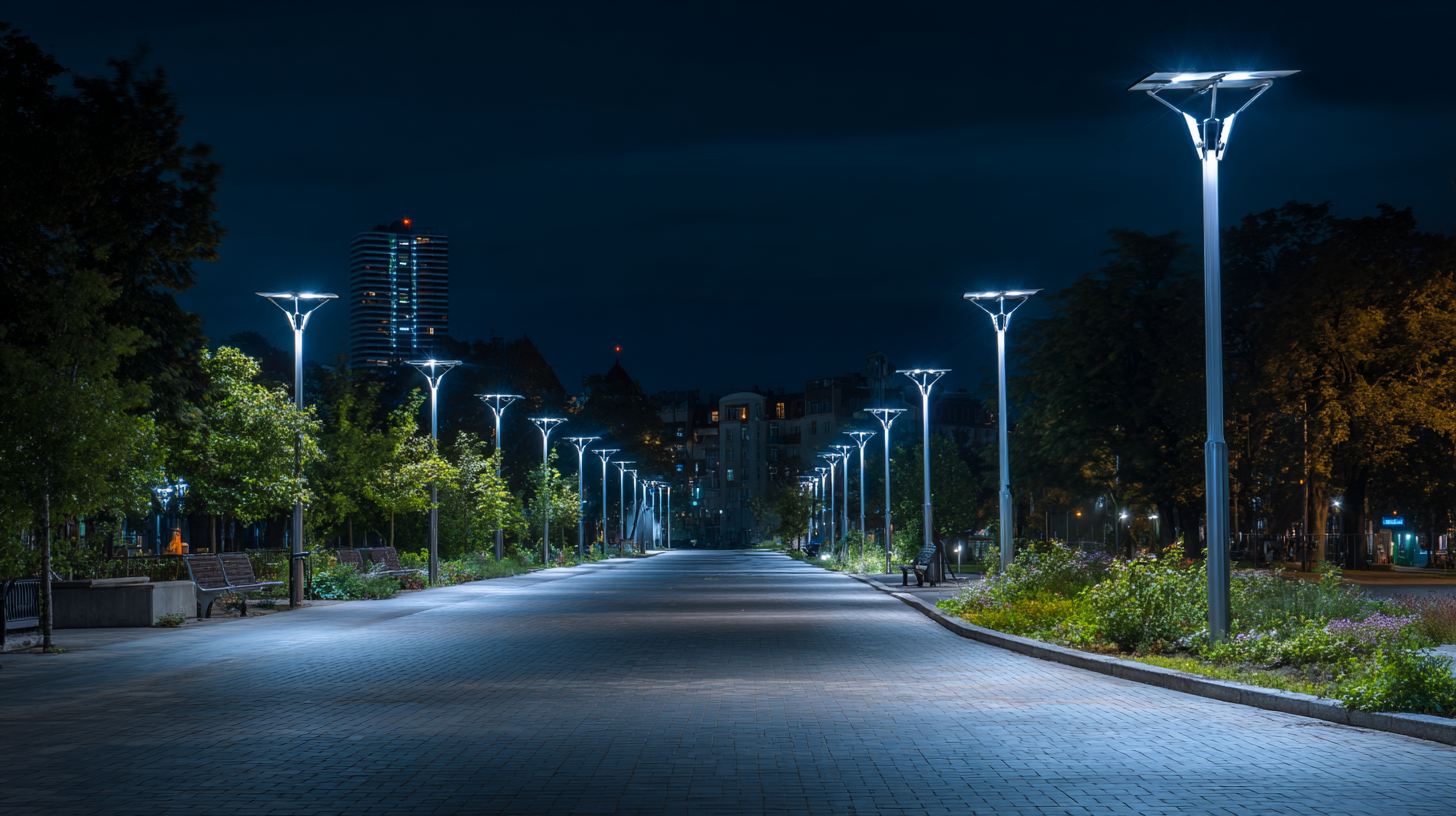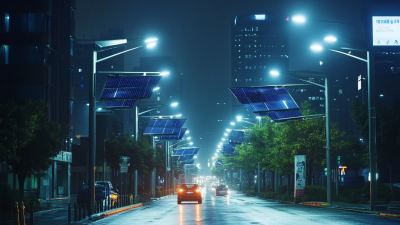Transforming Urban Spaces: The Future of Solar Street Lamps in Sustainable City Design
As urban areas continue to evolve, the integration of sustainable technologies into city design becomes increasingly crucial to combat climate change and enhance quality of life. One promising innovation is the solar street lamp, which harnesses renewable energy to illuminate public spaces while significantly reducing urban carbon footprints. According to a report by the International Energy Agency, the global market for solar street lighting is expected to grow at a compound annual growth rate (CAGR) of over 20% from 2021 to 2026, reflecting a rising demand for eco-friendly urban solutions. These solar street lamps not only provide energy-efficient lighting but also help cities adapt to the challenges of urbanization, such as light pollution and energy costs.
With advancements in solar technology and smart city integration, the future of solar street lamps holds the potential to transform urban landscapes, making cities not just greener but also more resilient in the face of environmental challenges.

The Role of Solar Street Lamps in Sustainable Urban Design
The integration of solar street lamps in sustainable urban design is rapidly gaining momentum as cities strive to reduce their carbon footprints and enhance energy efficiency. According to a report by the International Renewable Energy Agency (IRENA), the implementation of solar street lighting has the potential to decrease energy consumption by up to 50% compared to traditional lighting systems. This shift not only minimizes operational costs but also contributes to the overall sustainability goals set forth by urban planners.
Moreover, solar street lamps contribute to the enhancement of public safety and nighttime visibility. A study conducted by the U.S. Department of Energy highlights that well-lit neighborhoods experience a significant reduction in crime rates, affirming the importance of effective lighting in urban environments. By utilizing renewable energy sources, solar street lamps also promote social equity, particularly in underserved communities where access to reliable electricity may be limited. As cities continue to embrace sustainable design principles, the role of solar street lamps will be instrumental in fostering livable, safe, and environmentally friendly urban spaces.
Impact of Solar Street Lamps on Urban Sustainability
Innovative Technologies Enhancing Solar Street Lamp Efficiency
Recent advancements in solar technology are reshaping the landscape of urban lighting, particularly through the development of innovative solar street lamps. A notable breakthrough comes from researchers at the University of Rochester, who have created a novel type of solar thermoelectric generator (STEG) that significantly enhances energy conversion efficiency. This new technology captures a broader spectrum of solar energy and transforms it into usable electricity more effectively, which is pivotal for powering the next generation of solar streetlights in sustainable cities.

In parallel, the market for photovoltaic modules is experiencing robust growth, with the crystalline silicon solar module market projected to reach a staggering $380.74 billion by 2030, growing at a compound annual growth rate of 9.8% from 2024 to 2030. This reflects an increasing commitment to sustainable city designs that prioritize renewable energy sources. As cities continue to adopt solar street lamps, the integration of advanced technologies such as STEGs will not only significantly reduce urban energy costs but also enhance overall street lighting efficiency and reliability, contributing to safer and more sustainable urban environments.
Integrating Smart Features for Enhanced Urban Lighting Solutions
The integration of smart features into urban lighting solutions, particularly solar street lamps, represents a pivotal advancement in sustainable city design. By harnessing renewable solar energy, these lamps not only reduce dependency on traditional power sources but also diminish the carbon footprint of urban lighting systems. The incorporation of smart technology, such as sensors and connectivity options, allows for adaptive lighting that responds to pedestrian movement and environmental changes, enhancing safety and security in public spaces.
As cities increasingly adopt sustainable practices, the demand for intelligent lighting systems is expected to rise significantly. The ability to monitor energy consumption and control lighting remotely contributes not only to reduced operational costs but also to improved urban aesthetics. With the projected growth of the smart lighting market driven by innovations in IoT and sustainability initiatives, urban planners are presented with an opportunity to create more livable, efficient, and eco-friendly communities. This evolution in urban lighting aligns with the broader goals of smart city development, embedding technology into infrastructure to optimize resource usage and enhance the quality of urban life.

Case Studies: Successful Implementations of Solar Street Lamps
Cities around the world are increasingly turning to solar street lamps as a sustainable solution to urban lighting challenges. Several case studies highlight successful implementations, showcasing the effectiveness of solar solutions in enhancing safety and accessibility in public spaces. For example, in a rural project, construction crews in Anhekou village have successfully installed solar street lights, addressing the critical issue of inadequate nighttime lighting. This initiative not only improves security for residents but also promotes energy independence and environmental sustainability.
In urban areas like Yanlong, local governments are planning to install solar street lamps in multiple neighborhoods to resolve issues of darkened streets due to insufficient lighting. The proactive approach by municipal authorities to invest in solar technology reflects a commitment to improving community welfare and enhancing urban infrastructures sustainably. Meanwhile, ongoing competitive recognition within the solar street lamp sector emphasizes the growing importance of innovative and reliable products in meeting these urban demands, ensuring that cities can provide safer, well-lit environments while reducing their carbon footprint.
Transforming Urban Spaces: The Future of Solar Street Lamps in Sustainable City Design
| City |
Project Year |
Number of Lamps |
Energy Savings (%) |
CO2 Reduction (ton/year) |
Funding Source |
| City A |
2020 |
150 |
30 |
120 |
Government Grants |
| City B |
2019 |
200 |
25 |
150 |
Public-Private Partnership |
| City C |
2021 |
100 |
35 |
60 |
City Budget |
| City D |
2022 |
250 |
40 |
180 |
International Aid |
Future Trends in Solar Street Lighting for Sustainable Cities
As urban areas continue to grow, the integration of sustainable technologies becomes increasingly important.
Solar street lighting represents a significant trend in sustainable city design, offering cities an eco-friendly solution for nighttime illumination. By harnessing solar energy, these lamps not only reduce dependency on traditional electricity sources but also lower greenhouse gas emissions. The future of these systems lies in improving solar panel efficiency and battery storage capabilities, ensuring that urban spaces remain illuminated even during extended periods of cloudy weather.
Additionally, the design and functionality of solar street lamps are evolving. Smart technology integration allows these lamps to adjust brightness based on pedestrian movement, enhancing energy conservation while ensuring safety in urban environments. Future developments may also see the incorporation of sensors to monitor air quality or noise levels, transforming street lighting into multifunctional urban infrastructure. As cities strive for resilience against climate change, solar street lamps stand poised to play a pivotal role in creating sustainable, intelligent urban spaces.









